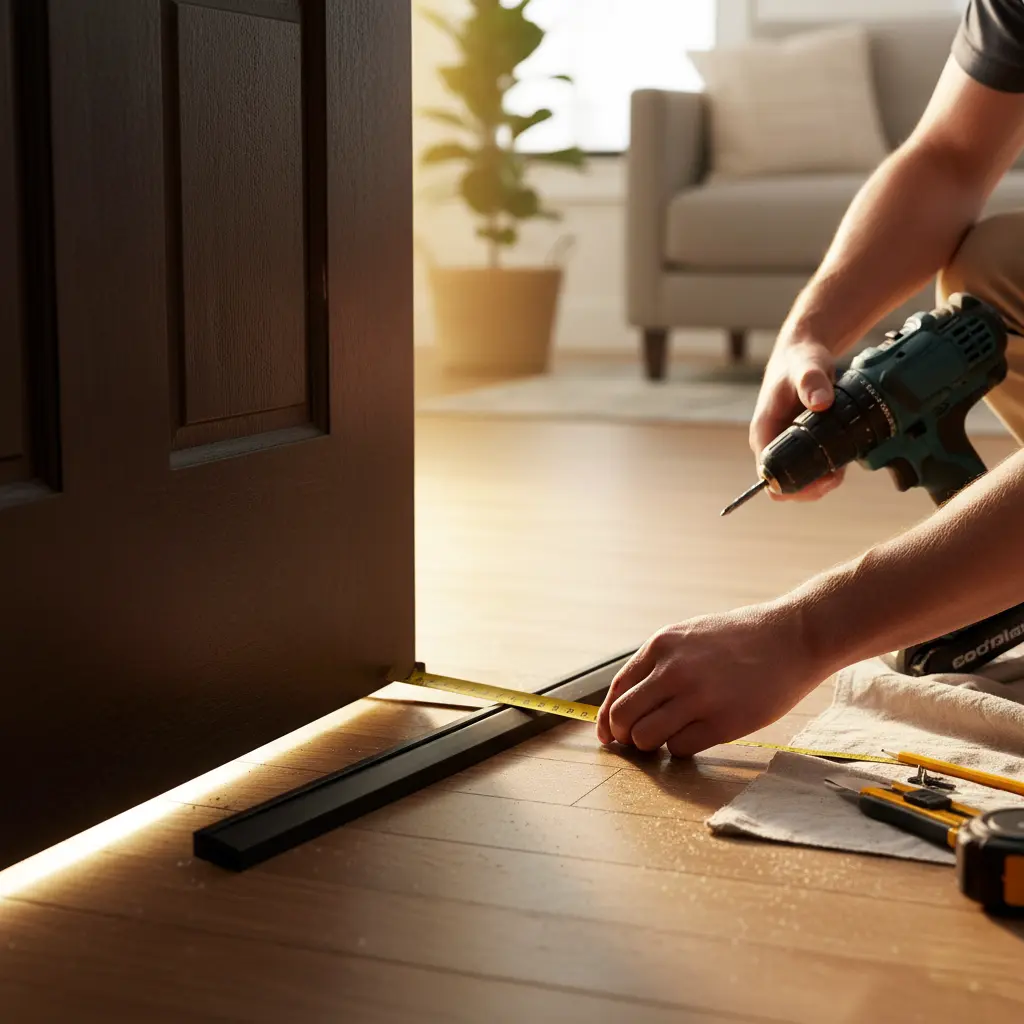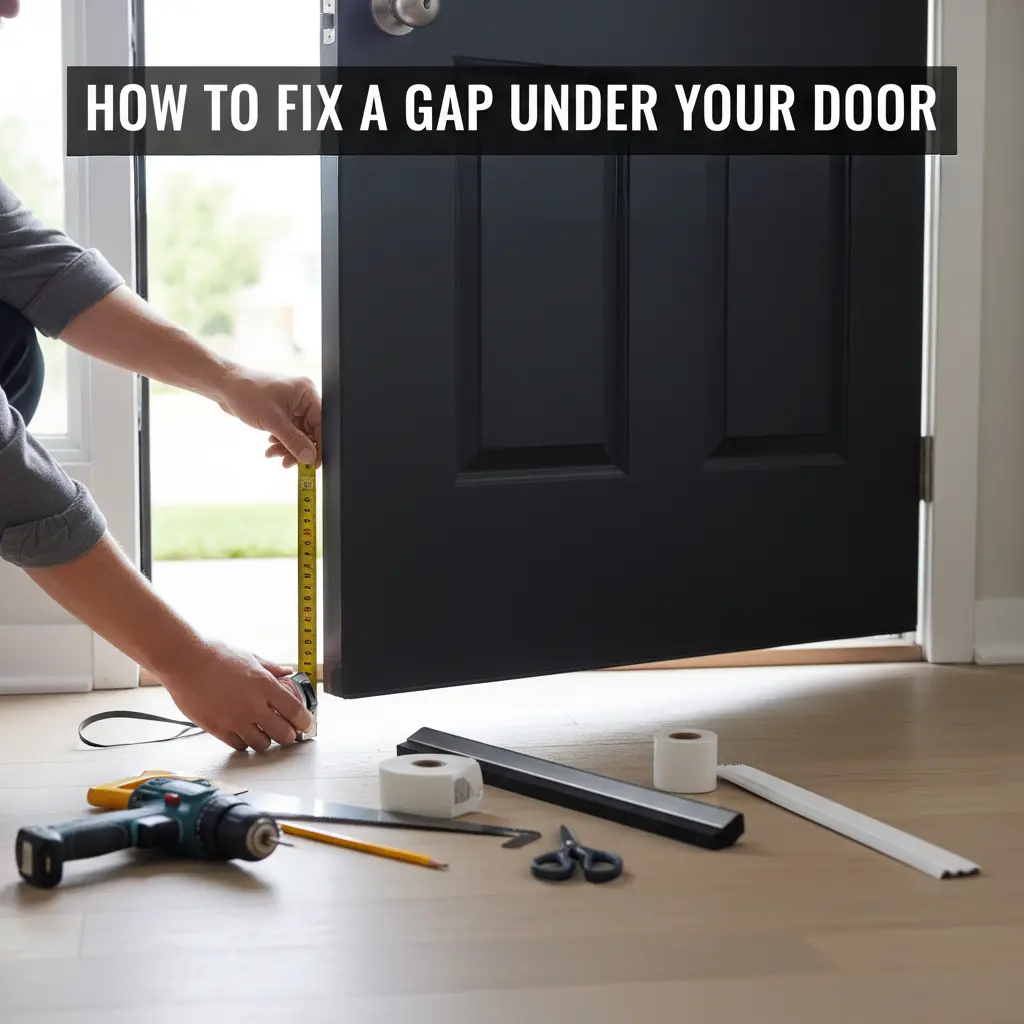That little gap under your front door might seem like a minor issue, but it can be a major source of discomfort and high expenses for homeowners and renters in Toronto and the GTA. From letting in chilly drafts during our tough Canadian winters to welcoming unwanted pests in the summer, that gap is more than just an eyesore. It’s a drain on your energy bills, a breach in your home’s comfort, and an open invitation for critters and noise.
Fortunately, fixing it is often a simple and rewarding DIY project. In this guide, we’ll walk you through the most effective solutions, from quick fixes like door sweeps and weatherstripping to more permanent solutions like new thresholds. You’ll learn how to identify the best option for your home, install it correctly, and know when it’s time to call in a professional for a long-term fix that will keep your home comfortable and secure for years to come.
Key Takeaways:
Before we dive in, here are the most important things to remember:
- Lower Your Energy Bills: A significant gap under your door can lead to noticeable heat loss in the winter and cool air loss in the summer, directly impacting your energy bills.
- Match the Solution to the Gap: The best solution depends on the size of the gap, your budget, and your DIY comfort level. Door sweeps are great for quick fixes, while new thresholds offer a more permanent seal.
- Boost Home Comfort & Stop Drafts: Sealing that gap is one of the easiest ways to eliminate drafts, reduce outside noise, and keep dust, pollen, and pests out of your home.
- Know When a Replacement is Needed: Sometimes, a gap is a symptom of a bigger problem, like a warped door or a damaged frame. In these cases, a professional solution is the most effective and cost-efficient choice in the long run.
Door Gap Solutions: A Quick Comparison
| Solution Type | Materials Cost | Installation Difficulty | Best For |
| Door Sweeps | $20 – $80 | Easy | Small to medium gaps, quick fixes, renters. |
| Weatherstripping | $12 – $50 | Easy | Sealing gaps around the entire door frame. |
| Thresholds | $50 – $140+ | Moderate | Large or uneven gaps, long-term seals. |
1. Install a Door Sweep: A Quick & Easy Fix
What is it? A door sweep is a long strip of material—typically aluminum or vinyl with a brush or rubber seal—that attaches to the bottom of your door. They are designed to cover the gap between the door and the threshold. Types range from simple stick-on vinyl sweeps to more durable screw-on models with flexible rubber fins.
Pros:
- Budget-Friendly Solution: Very affordable and widely available at hardware stores.
- Easy DIY Installation: Simple to install, often requiring just a few screws or a self-adhesive strip.
- Blocks Drafts, Pests, & Dust: Effective at sealing the gap against common intruders.
Cons:
- Requires Eventual Replacement: The adhesive or rubber parts can wear out over time with use.
- Potential for Floor Dragging: May drag on carpets or flooring if not installed at the correct height.
- Best for Smaller Gaps: Not the ideal solution for very large or uneven gaps.
2. Apply Weatherstripping: A Versatile Seal
What is it? While often used for the sides and top of a door frame, certain types of weatherstripping, like foam or rubber seals, can be applied to the threshold or the door bottom. It’s typically sold in rolls with a self-adhesive backing, making it a simple peel-and-stick application.
Pros:
- Low-Cost & Simple to Apply: Extremely inexpensive and easy for anyone to install.
- Effective Air and Noise Seal: Creates a tight compression seal that blocks air and noise.
- Removable & Renter-Friendly: Great for renters as it can usually be removed without damage.
Cons:
- Adhesive May Weaken Over Time: Can fail in high-traffic areas or extreme temperatures.
- Foam Can Lose Shape: Foam types can compress and lose their effectiveness with use.
- Less Durable for High Traffic: Not always durable enough for the bottom of a busy exterior door.

3. Adjust or Replace Your Door Threshold: A Permanent Solution
What is it? A threshold is the plate at the bottom of your doorway that you step over. Many modern thresholds are adjustable, with screws that allow you to raise or lower a vinyl or rubber insert to create a perfect seal against the bottom of the door.
Pros:
- Durable & Permanent Seal: Provides a long-lasting and highly effective seal against the elements.
- Adjustable for Uneven Gaps: Can be fine-tuned to fix uneven gaps or to account for a settling foundation.
- Clean, Professional Appearance: Creates a professional, finished look for your entryway.
Cons:
- More Complex Installation: Replacing a threshold is a more involved job that may require cutting.
- Higher Initial Cost: A higher upfront cost compared to simple sweeps or weatherstripping.
- May Need a New Door Bottom: Often works best when paired with a new door bottom seal.
How to Choose and Install Your Door Gap Solution
What’s the Best Way to Fix Your Door Gap?
Choosing the right solution is simple if you follow these steps:
- Measure the Gap: Close the door and measure the gap’s height from the top of the threshold to the bottom of the door. Check the measurement at several points, as the gap may be uneven.
- Assess Your Door and Threshold: Is your door straight or warped? Is the threshold old, worn, or damaged? If the underlying components are in poor condition, a simple fix might not be enough.
Choose Your Product:
- For small, even gaps (under 1/2 inch): A simple adhesive door sweep or high-density foam weatherstripping is a great starting point.
- For medium gaps (1/2 to 3/4 inch): A screw-on door sweep with a rubber or vinyl seal is a more durable choice.
- For large or uneven gaps: An adjustable threshold is the most effective and permanent solution.
Quick Installation Guide for Door Sweeps
For a standard screw-on door sweep, follow these general steps:
- Measure and Cut: Measure the width of your door and cut the door sweep to size with a hacksaw.
- Position the Sweep: Close the door and position the sweep on the interior side, ensuring the rubber seal lightly touches the threshold to create a seal without dragging.
- Mark the Holes: Use a pencil to mark where the screws will go.
- Drill Pilot Holes: Drill small pilot holes to make installing the screws easier and prevent the door from splitting.
- Attach the Sweep: Secure the sweep to the door with the provided screws. Test the door to ensure it opens and closes smoothly.
When to Call a Professional for a Long-Term Door Fix
Sometimes, a gap under the door is a sign of a more serious issue that a DIY fix can’t solve. Here are signs that you need a professional:
- Warped or Cracked Door: If the door itself is bent, twisted, or has visible cracks, it will never seal properly. This compromises not only your energy efficiency but also your home’s security.
- Damaged or Rotted Frame: A door frame that is soft, splintered, or shows signs of water damage needs to be replaced. A damaged frame can’t support a door correctly, leading to gaps and security risks.
- Significant Water Intrusion: If water is leaking under your door during rain, the threshold and subfloor could be at risk of serious damage.
- The Foundation Has Settled: If the door is no longer level with the frame and threshold due to the house settling, a simple fix won’t address the core problem.
If your door is warped or the frame is damaged, a simple sweep won’t solve the underlying problem. A professionally installed, high-quality door from Enlive Doors ensures a perfect seal, enhances your home’s security, and provides lasting energy efficiency. Our experts can assess the root cause of the gap and recommend a solution that will protect your home for years to come.
Check for Other Common Door Drafts
While you’re focused on the bottom of the door, don’t forget these other common culprits for drafts:
- Around the Door Frame: Check the weatherstripping along the sides and top of the door. If it’s cracked or compressed, replace it.
- The Keyhole or Mail Slot: Uncovered keyholes and mail slots can be a surprising source of cold air. Consider installing covers for them.
- The Door’s Glass Inserts: Check the seals around any glass panels in your door. Old glazing or seals can crack and let in drafts.
Conclusion
Fixing a gap under your door is a small project that delivers big rewards in comfort, pest control, and energy savings. Whether you choose a quick DIY fix or a more permanent solution, sealing that gap is a smart investment in your home. Ready to stop the drafts and lower your energy bills for good? Contact Enlive Doors today at (647) 371-5756 for a professional consultation on our range of perfectly sealed, energy-efficient doors!



